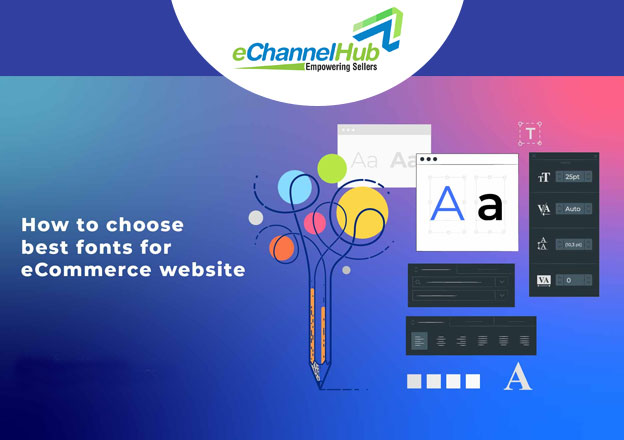How does typography on eCommerce website design influence the user experience and perception of a brand?

When it comes to eCommerce website design, every element plays a crucial role in shaping the user experience and perception of a brand. And one such element that often gets overlooked is typography. The choice of fonts, spacing, and alignment can have a significant impact on how users perceive your brand and navigate your website.
In this blog, we will delve into the importance of typography in brand perception and explore the relationship between typography and user experience. We will uncover the psychology behind typography and how it influences user behavior and emotions. Additionally, we will discuss how typography influences purchase decisions and affects conversion rates.
Furthermore, we will highlight common typographical mistakes to avoid in eCommerce website design and provide best practices for using typography effectively. So if you’re looking to enhance your eCommerce website’s user experience, boost brand perception, and drive more conversions, stay tuned for some valuable insights into the world of typography.
Importance of Typography in Brand Perception
Typography plays a vital role in shaping the perception of a brand. It sets the tone and personality, evoking specific emotions that can attract or repel customers. Consistency in typography across an eCommerce website enhances brand recognition and fosters trust among users. Readability is crucial for a positive user experience, so choosing the right font size, spacing, and line height is important. By carefully selecting typography, a brand can differentiate itself from competitors and establish a unique identity in the market. Incorporating NLP terms such as typography, eCommerce, typeface, fonts, user experience, and usability, among others, helps optimize the content for search engine optimization (SEO) and ensures that it meets the needs of potential customers.
The Relationship between Typography and User Experience
Typography plays a crucial role in shaping the user experience (UX) of eCommerce websites. The choice of typography sets the tone and personality of a brand, while also influencing users’ perception of it. Clear and legible typography improves readability, making it easier for users to navigate and understand the content on web pages. Consistency in typography across the website creates a cohesive brand identity, enhancing brand recognition. Moreover, typography hierarchy helps guide users through the website, emphasizing important information and guiding them towards desired actions. By carefully selecting font styles and sizes, designers can evoke specific emotions and establish trust with users. Responsive typography ensures a seamless experience across different devices, allowing users to engage with the brand regardless of the platform they’re using. Overall, typography is a powerful tool for enhancing the user experience and perception of a brand.
How Typography Shapes Brand Identity on eCommerce Websites
Typography plays a pivotal role in shaping the brand identity of eCommerce websites. The choice of fonts has a significant impact on the user experience and perception of a brand. Consistency in typography across the website creates a cohesive and professional brand image, fostering trust and credibility. Different fonts evoke specific emotions and associations, influencing how users perceive the brand. By selecting the right typefaces, designers can enhance the hierarchy and organization of information on the website, guiding user attention to important elements. Typography sets the tone and personality of a brand, while also impacting readability and user engagement. In summary, typography on eCommerce websites plays an integral role in crafting a distinct brand identity and creating a positive user experience.
1. Role of Typography in Establishing Brand Identity
When it comes to eCommerce websites, first impressions matter. The moment a visitor lands on a website, they start forming opinions about the brand. Typography, the art of arranging and styling typefaces, plays a crucial role in shaping that initial impression. It sets the tone, conveys the brand’s personality, and enhances the overall user experience.
Effective typography creates a visual language that aligns with the brand’s identity and resonates with its target audience. It goes beyond simply choosing fonts; it involves understanding the psychology of typography and its impact on perception. By carefully selecting fonts, typography styles, and layouts, businesses can create a unique and memorable brand experience that sets them apart from their competitors.
2. Creating Consistency: Selecting the Right Fonts
Consistency is key when it comes to establishing a strong brand identity. The fonts used throughout an eCommerce website should be consistent with the brand’s visual identity and values. This includes selecting fonts that reflect the brand’s personality, whether it’s modern and minimalistic or elegant and sophisticated.
Moreover, using a limited set of fonts creates a cohesive and harmonious visual experience for users. It’s advisable to choose a primary font for headings and a secondary font for body text to maintain consistency. These font choices should be carried across all pages of the website, including product descriptions, blog posts, and contact information, to reinforce the brand’s identity.
3. Setting the Tone: Typography Styles and Brand Personality
Typography styles, such as bold, italic, or handwritten fonts, can help express the brand’s personality and set the tone of the website. For instance, a brand aiming for a fun and playful image may use a whimsical script font, while a professional and corporate brand may opt for a clean and structured font.
The chosen typography styles should align with the brand’s values, target audience, and the overall message the brand wants to convey. Consistency in using typography styles across different sections of the website enhances the user experience and reinforces the brand’s identity.
4. Enhancing Readability: The Importance of Legible Typography
In the online world, where attention spans are short, readability is crucial. If users struggle to read the content on an eCommerce website, they are more likely to leave and search for alternatives. Therefore, selecting legible fonts and optimizing typography for readability is essential.
Key factors for enhancing readability include choosing fonts with appropriate letter spacing, line height, and font size. Clear and well-spaced typography ensures that users can effortlessly skim through product descriptions, blog posts, or any other written content on the website. Additionally, using a contrast between font color and background color improves readability, especially for users with visual impairments.
5. Establishing Hierarchy: Using Typography for Visual Organization
Effective use of typography helps establish a visual hierarchy on eCommerce websites. Hierarchy guides users’ attention and helps them navigate through the content with ease. By utilizing different font sizes, weights, and styles, businesses can emphasize important information and guide users toward specific actions.
For example, the use of larger and bolder fonts for headings (H1 tags) grabs attention and introduces sections, while smaller fonts for subheadings (H2 tags) provide structure and organization. This visual hierarchy enhances the user experience by making the content scannable and easy to comprehend.
6. Differentiating from Competitors: Unique Typography Choices
In a highly competitive eCommerce landscape, standing out from competitors is vital. Typography can serve as a differentiating factor, allowing businesses to create a unique brand identity. By selecting distinctive fonts or customizing existing ones, brands can create a memorable visual identity that sets them apart.
However, it’s essential to strike a balance between uniqueness and usability. Typography choices should still be legible and accessible to a wide range of users. Unique fonts should enhance the brand’s personality and message without compromising readability or usability.
7. Accessibility and Inclusivity: Typography for All Users
Designing eCommerce websites with accessibility in mind is crucial to ensure that all users can engage with the content. This includes considering typography choices that cater to users with visual impairments or reading difficulties.
Using accessible fonts with clear letterforms, ample spacing, and appropriate contrast ratios between text and background is essential. Additionally, providing options for users to adjust font sizes and utilizing alternative text for images further enhances the inclusivity of the website.
8. Mobile Responsiveness: Optimizing Typography for Small Screens
With the increasing use of mobile devices for online shopping, optimizing typography for small screens is paramount. Text that is too small or cramped can hinder the user experience and lead to frustration. Therefore, responsive design principles should be applied to ensure typography adapts to different screen sizes.
Using font sizes that are comfortable to read on mobile devices, adjusting line lengths, and optimizing spacing and alignment for smaller screens are crucial considerations. By prioritizing mobile responsiveness, businesses can provide a seamless and enjoyable experience for their mobile users.
9. Building Trust: Typography and Credibility
Typography has a significant impact on how users perceive a brand’s credibility and trustworthiness. Well-executed typography creates a sense of professionalism and attention to detail, instilling confidence in the brand. On the other hand, poorly chosen typography can give a perception of amateurism or lack of reliability.
By selecting fonts that align with the brand’s image and values, businesses can establish a sense of trust and credibility with their audience. Consistent and thoughtful typography choices convey that the brand pays attention to every aspect of its online presence, including the visual details.
10. Future Trends: Innovations in eCommerce Typography
Typography is a dynamic field, and new trends and innovations continuously emerge. As technology advances, new possibilities arise for creative typography implementation on eCommerce websites. For example, variable fonts offer flexibility in adjusting weight, width, and other attributes in real time.
Staying up-to-date with the latest trends and innovations in eCommerce typography allows businesses to leverage new opportunities for enhancing their brand identity. It demonstrates a commitment to innovation and ensures the brand remains relevant and visually appealing in the ever-changing digital landscape.
Conclusion:
Typography in eCommerce website design is pivotal to user experience and shaping brand perception. It not only elevates readability and ease of navigation but also communicates the brand’s character, impacting user emotions and perceptions. Proper typography boosts user trust and engagement, thus being integral to a brand’s online success. Consequently, careful incorporation of typography into design strategy is vital for enriching customer interactions and fostering enduring relationships.
Author Bio: I am Rushik Shah, an experienced digital marketing expert with a strong focus on web design and user experience. I specialize in responsive web design and understand its importance in the mobile-first era. With a deep knowledge of search engine optimization and user engagement, I have a proven track record of implementing successful online strategies. I am dedicated to helping businesses thrive in the dynamic world of digital marketing.
Write For Us
Gain multichannel inventory visibility and control with eChannelHub
Learn more about eChannelHub with a free demo, tailored for your unique retail business.
Request A DemoRequest a Demo
Gain multichannel inventory visibility and control with eChannelHub
Learn more about eChannelHub with a free demo, tailored for your unique online business




